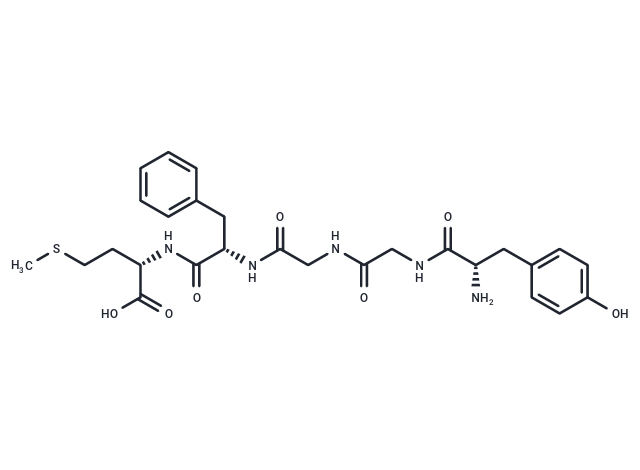Shopping Cart
- Remove All
 Your shopping cart is currently empty
Your shopping cart is currently empty

Tyr-Gly-Gly-Phe-Met-OH (Met-Enkephalin) is a naturally occurring endogenous opioid peptide that inhibits tumor growth by binding to the opioid receptor.

| Pack Size | Price | Availability | Quantity |
|---|---|---|---|
| 10 mg | $30 | In Stock | |
| 25 mg | $52 | In Stock | |
| 50 mg | $83 | In Stock | |
| 100 mg | $131 | In Stock | |
| 200 mg | $193 | In Stock | |
| 1 mL x 10 mM (in DMSO) | $32 | In Stock |
| Description | Tyr-Gly-Gly-Phe-Met-OH (Met-Enkephalin) is a naturally occurring endogenous opioid peptide that inhibits tumor growth by binding to the opioid receptor. |
| In vitro | Tyr-Gly-Gly-Phe-Met-OH,as know as Methionine enkephalin (MENK), an endogenous neuropeptide has a crucial role in both neuroendocrine and immune systems.?MENK is believed to have an immunoregulatory activity to have cancer biotherapy activity by binding to the opioid receptors on immune and cancer cells.?Clinical trial studies in cancer patients have shown that MENK activates immune cells directly and by inhibiting regulatory T-cells (Tregs).?MENK may also change the tumor microenvironment by binding to opioid receptor on or in cancer cells.?All of these mechanisms of action have biologic significance and potential for use in cancer immunotherapy.?Furthermore, they reveal a relationship between the endocrine and immune systems. |
| Alias | Methionine enkephalin, Met-Enkephalin |
| Molecular Weight | 573.66 |
| Formula | C27H35N5O7S |
| Cas No. | 58569-55-4 |
| Smiles | CSCC[C@H](NC(=O)[C@H](Cc1ccccc1)NC(=O)CNC(=O)CNC(=O)[C@@H](N)Cc1ccc(O)cc1)C(O)=O |
| Relative Density. | 1.324 g/cm3 |
| Storage | keep away from moisture | Powder: -20°C for 3 years | In solvent: -80°C for 1 year | Shipping with blue ice. | ||||||||||||||||||||||||||||||
| Solubility Information | DMSO: 40 mg/mL (69.73 mM), Sonication is recommended. | ||||||||||||||||||||||||||||||
Solution Preparation Table | |||||||||||||||||||||||||||||||
DMSO
| |||||||||||||||||||||||||||||||

Copyright © 2015-2025 TargetMol Chemicals Inc. All Rights Reserved.